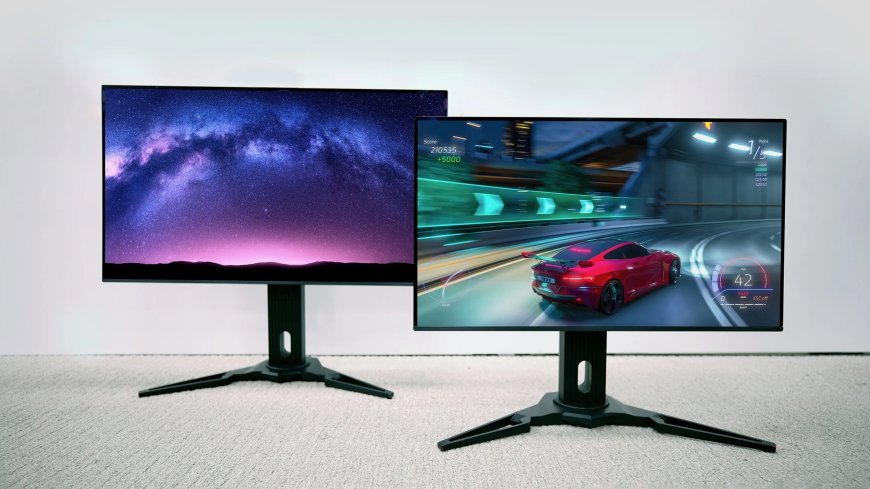Superb PC Gaming with Next-Gen 4K QD-OLED Monitors
In this comprehensive article, we delve into the world of cutting-edge gaming monitors, specifically the MSI MPG 321URX, which boasts a 32-inch 4K 240Hz QD-OLED panel. While we can't provide performance data due to it being a pre-production unit, we'll share everything you need to know about this exciting product. Join us on this journey as we explore the features, availability, and pricing of the MSI 321URX and take a glimpse into the competitive landscape of gaming monitors in 2024.

Overview of the MSI MPG 321URX
The MSI MPG 321URX is poised to make its debut in the gaming monitor market, catering to gamers in the US, Europe, Australia, and New Zealand. It's scheduled to hit the shelves in February, with a broader release slated for March, priced at $1,200. While this might seem like a premium price tag, it's important to note that it falls in line with other high-end OLED displays, especially when considering that 1440p 240Hz WOLED monitors now come in at around $800. In the realm of premium gaming monitors, the MSI 321URX stands as a worthy contender.
Also check DDR5 vs. DDR4: A Fresh Look at Gaming Performance
The Competitive Landscape in 2024
As we embark on this journey of discovery, it's evident that the gaming monitor landscape in 2024 is poised for fierce competition. The MSI 321URX is just one of many monitors featuring the coveted 4K QD-OLED panel. Competing models from Asus, Dell, Samsung, and other reputable brands are also set to hit the market soon. Notably, LG Display is introducing a second 32-inch 4K 240Hz OLED panel, offering a unique dual-mode functionality that doubles as a 1080p 480Hz display. With multiple panel manufacturers vying for this specification, gamers can anticipate a heated battle that will likely keep prices competitive and reasonable.
Exploring the Basics and Specifications
2nd-Generation QD-OLED Panel
The MSI 321URX boasts a 2nd-generation QD-OLED panel, distinguished by a smaller pixel structure that enables a higher density 4K resolution. This is a significant advancement compared to recent 49-inch super-ultrawide QD-OLED monitors. Additionally, the display incorporates additional pixels for pixel shifting functionality while maintaining a full 3840 x 2160 resolution, a feature commonly seen in gaming OLED monitors.
Impressive Response Time
MSI claims an astonishing 0.03ms grey-to-grey response time for the 321URX. While we can't provide performance data at this time, it's worth noting that this response time aligns with the expected range for OLED monitors, typically falling between 0.2 to 0.3ms based on our testing. Gamers can expect ultra-fast response times for an immersive gaming experience.
Brightness and HDR Capabilities
When it comes to brightness, MSI quotes 250 nits of typical brightness for full-screen sustained SDR usage and an impressive 1,000 nits of peak brightness for HDR content. While we can't present specific measurements just yet, these figures closely mirror what we've observed from other QD-OLED monitors. Notably, the MSI 321URX is DisplayHDR True Black 400 certified, a notable distinction that sets it apart from traditional LCD monitors with DisplayHDR 400 certification.
As we eagerly await the official release of the MSI MPG 321URX and the opportunity to conduct thorough performance testing, it's clear that this monitor has the potential to redefine the gaming experience. With its cutting-edge QD-OLED panel, rapid response times, and impressive HDR capabilities, it promises to deliver a gaming experience like no other.
The Future of Gaming Monitors
In this section, we'll take a moment to reflect on the broader implications of the MSI 321URX and the wave of next-gen gaming monitors set to flood the market. The introduction of 4K QD-OLED panels marks a significant milestone in the world of gaming displays. These panels offer unparalleled visual quality, with vibrant colors, deep blacks, and lightning-fast response times. Gamers can look forward to a future where every pixel is a masterpiece and every frame is a work of art.
The Impact on Gamers
For gamers, this next generation of monitors opens up a world of possibilities. Whether you're a competitive esports enthusiast or a single-player RPG aficionado, the benefits of these monitors are undeniable. The combination of 4K resolution and high refresh rates, such as 240Hz, ensures that every motion is fluid and every detail is crystal clear. This level of clarity and responsiveness can be the difference between victory and defeat in fast-paced games.
Additionally, the HDR capabilities of monitors like the MSI 321URX elevate the visual experience to new heights. With peak brightness reaching 1,000 nits, HDR content comes to life with breathtaking contrast and vibrant colors. Whether you're exploring a post-apocalyptic wasteland or battling mythical creatures in a fantasy realm, the immersion is unparalleled.
The Role of Competition
As we look ahead to 2024 and beyond, the competitive landscape of gaming monitors becomes a key factor in shaping the industry. With multiple manufacturers producing 4K QD-OLED panels and other high-performance displays, gamers can expect more choices and competitive pricing. The MSI 321URX is just the beginning of what promises to be a golden era for gaming monitors.
Conclusion
In conclusion, the MSI MPG 321URX with its 4K QD-OLED panel represents a significant leap forward in the world of gaming monitors. While we eagerly await the opportunity to conduct in-depth performance testing, the specifications and features on offer are undeniably impressive. With a competitive price point and a crowded field of next-gen gaming monitors on the horizon, gamers can look forward to a future where their gaming experiences are truly exceptional.
As the gaming monitor industry continues to evolve and innovate, one thing is clear: the future of gaming looks brighter and more immersive than ever before. Whether you're a casual gamer or a dedicated enthusiast, monitors like the MSI 321URX are poised to elevate your gaming experience to new heights. Get ready for a gaming revolution in 2024 and beyond, where every pixel counts and every frame matters.


































